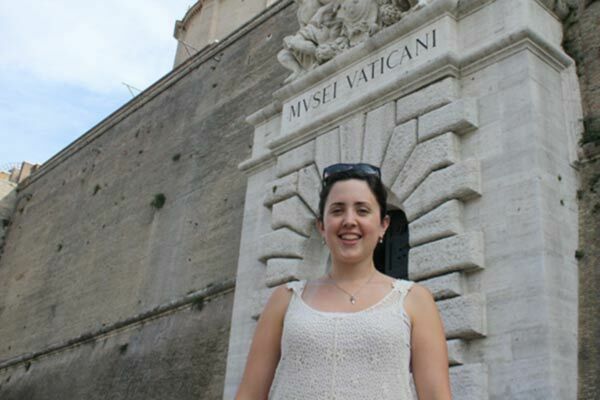
Maria Giulia Genghini is a graduate student in the Ph.D. in Literature program who received a Graduate Travel and Research Grant to conduct archival research in Rome. Since the Nanovic Institute has sent her to Rome before, this trip consisted in conducting in-depth analysis of the materials that she located during her first stay, as well as in making key professional contacts. This is a trend among our grant recipients: good research often begets the need for more good research. She recently wrote to us about her experience:
As a recipient of this Graduate Travel and Research Grant, I was able to return to Rome and pursue further archival research on my dissertation’s manuscript, held at the Archivum Romanum Societatis Iesu. This was truly an invaluable opportunity for me at this stage of my Ph.D. and I will never forget the generosity of the Nanovic Institute in assisting me with it.
Rome is an overwhelming city, full of hidden remnants of a glorious past. This is true not only for its architectural landscape, which is self-explanatory as it combines Roman buildings and catacombs, Renaissance palaces and squares, and some of the most beautiful churches of all times. Even its literary and archival patrimony conceals the density of such historical past.
For this reason, my first trip to the eternal city, which was also made possible thanks to the generosity of the Nanovic Institute, had the character of a preliminary investigation for the identification of all resources which could be of help to my research. My focus is on Renaissance Jesuit literature and its reception of classical and patristic sources. Even though it was one of the later religious order to be established (1540), the Jesuits organized themselves with a high degree of efficiency, expecting all their members to contribute to the life of the Society both with annual reports and with literary productions. This resulted in the creation of an immense archive, which got disseminated among several institutions at the time of the order’s suppression (1767).
To be able to return to Rome and conduct in-depth analysis of the material retrieved in my first stay was key to the development of my research project and its timeline. The Nanovic support was essential as it enabled me to find housing conveniently located 10 minutes walk from the main Jesuit archives, which are located next to the Vatican, in one of the most expensive neighborhoods of Rome (Prati). Transportation in Rome is not at all smooth and living walking distance from the archives gave me the chance to take advantage of the limited working hours permitted by ARSI. Prati neighborhood is also tremendously convenient for reaching other two main Jesuit archives, the “Biblioteca Nazionale” and the Pontifical Gregorian University. As I am conducting comparative research among different manuscripts that represented the development of the Jesuit literary tradition between Rome and overseas Jesuit missions, it proved essential for me to enjoy facilitated access to primary material.
Alongside my research, the Jesuit archives at Borgo Santo Spirito have become a familiar place where I began establishing both academic and friendly relationships with colleagues and archivists. During this past visit, I met with Professor Pamela Jones (Art History, University of Massachusetts) and we talked thoroughly about my project. At the end of our conversion, she put me in contact with a colleague of her (Prof. Simon Ditchfield, University of York) who is interested in becoming an external reader for my dissertation.
Furthermore, the friendship with ARSI culminated in the request to submit an article for the Spring 2016 number of their biannual journal Archivum Historicum Societatis Iesu (AHSI). It will be my pleasure to acknowledge in this article how the Nanovic support was essential in fostering research and academic networking during the most important years of my Ph.D.